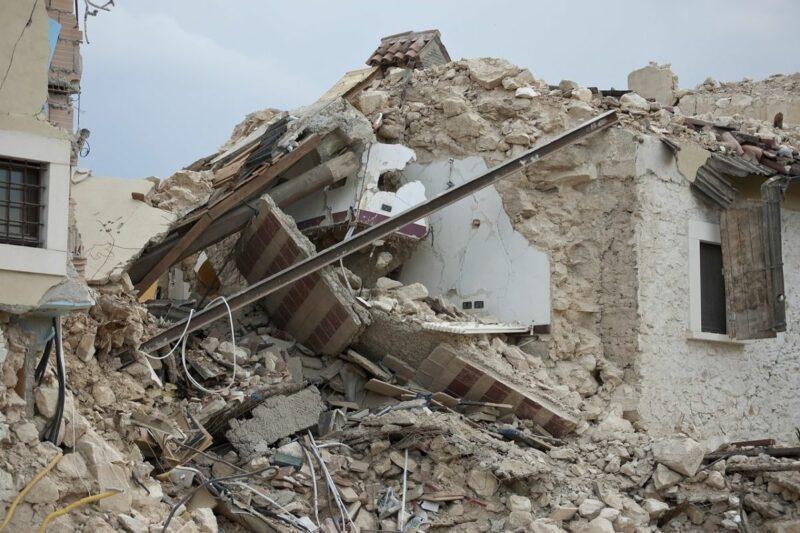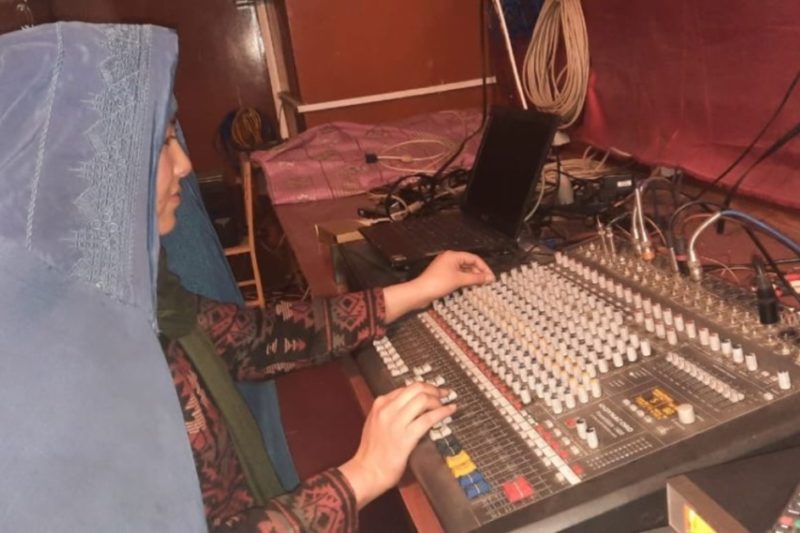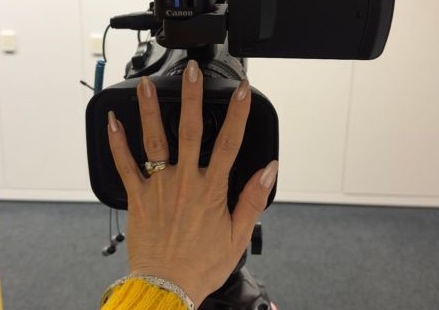The Taliban have officially banned the celebration of Nowruz in Afghanistan

Nowruz is the celebration of the new year that begins on 21 March and of the first day of spring. The holiday has a long history, because before the birth of Afghanistan and Iran, it was already celebrated, and that's why the Taliban rejected both the party and the holiday !
The first day of spring is 21 March in the northern hemisphere. But that day is also the beginning of a new year for 300 million people around the world. In Iran and Afghanistan, where the solar calendar begins with the spring equinox, Nowruz, which means « new day, » is a festival that celebrates both the beginning of spring and the first day of the year.
Many people start making plans for Nowruz, customarily observed at the vernal equinox, weeks in advance.
Before the Nowruz, everywhere, you can hear the song “Bia Ke Borem Ba Mazar Mula Mahamad Jan”, which means Let’s go to the lover city of Mazar-e-Sharif, which is located in North of Afghanistan.
Many preparations are to be made for Nowruz
For more than 3,000 years, Nowruz, also known as the Persian New Year, has been a festival in Iran and Afghanistan. It is based on the Hijri Shamse solar calendar associated with Zoroastrianism, a religion prevalent in prehistoric Persia that saw the arrival of spring as a triumph over winter and darkness.
In Afghanistan, there are many preparations to be made for Nowruz, including repainting rooms, washing curtains, and cleaning the whole house – we call it « Khana Takani » – as well as buying new clothes for all family members and organizing a trip to Balkh province to the famous city of Mazar-e-Sharif. In the days leading up to the festival, people perform ritual dances and fill their buckets with water; this is associated with health and helps to ward off or chase away bad luck.
In many places in Afghanistan, a week before Nowruz, people gather in the evening to light fires. Women prepare different dishes and people read famous poems by Maulana Jalaluddin Balkhi Rumi, Omar Khayyam, and Hafiz Shirazi and dance.
The spring festival is placed under the sign of fertility and new life. It is therefore natural that many revellers use seeds and eggs to celebrate the event. Households set up tables covered with seven symbolic objects that they call « haft-mewa » and « haft-seen ». Haft means « seven » and « seen » translates to « s » in Farsi, and all the objects start with this letter.
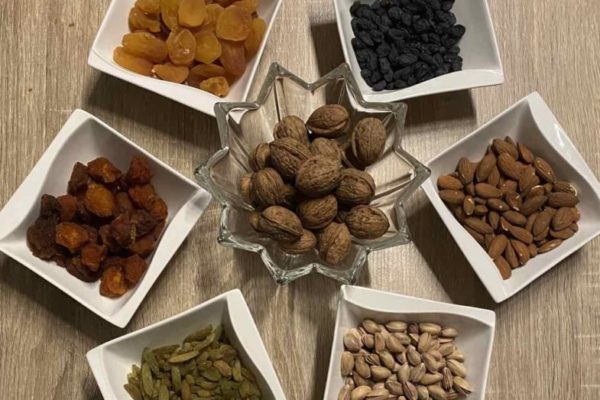
This is seven dry fruits before preparation, © Lailuma Sadid
We also have seven kinds of dried fruit, which are called « haft-mewa ». When do we prepare these? Two days before Nowruz. we wash them and put them in a large dish with cold water for two days in order to be ready for Nowruz morning. They may include raisins, elderberries, pistachios, walnuts, dried apricots, almonds, hazelnuts, or cherries.
There are also sprouted seeds, senjed (supposed to inspire love), garlic (associated with protection), apples (fertility), sumac (love), vinegar (patience), and a pudding made from sprouted wheat (opulence) called samanu (wealth). The table may also contain a Qur’an, a book of Maulana poetry, eggs, and mirrors. People believe that seven fruits on the day the year begins are a good omen. As a blessing to the house, they are gathered on the table.
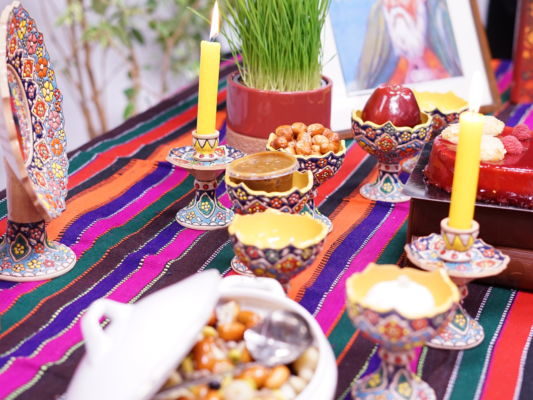
The haft-seen table at the Nowruz party in Brussels, © Lailuma Sadid
This festival is also recognized in Afghanistan, Albania, Azerbaijan, Georgia, Iraqi Kurdistan, Kazakhstan, Kosovo, Kyrgyzstan, a small part of the Mongolian province of Bayan-Ölgii, Tajikistan, Turkmenistan, and Uzbekistan. Turkey, India, and other countries with Persian enclaves are also among the countries where this festival is widely observed.
UNESCO, the United Nations Educational, Scientific, and Cultural Organization, contributes to peace and security by promoting international cooperation in education, science, culture, communication, and information. UNESCO officially recognized the holiday as International Nowruz Day on 21 March 2009. In February 2010, the United Nations General Assembly also recognized Nowruz as a global event.
According to information provided by the UN on the significance of Nowruz, « Nowruz marks the beginning of the New Year for more than 300 million people worldwide, and has been celebrated for more than three thousand years in the Balkans, the Black Sea region, the Caucasus and Central Asia. Celebrations are also held in the Middle East and elsewhere. »
The Taliban administration’s Ministry for the Promotion of Virtue and Prevention of Vice has declared Nowruz an « un-Islamic holiday » and ordered that no one in Afghanistan should observe or celebrate it.
One of the ministry’s employees, Mohammad Yahya Aref, stressed in a video message published by the Ministry for the Promotion of Virtue and Prevention of Vice that Nowruz is not a Muslim holiday and said, « Those who celebrate Nowruz and respect it are leaving the circle of Islam. » He pointed out that Nowruz is « the festival of the Magi, the festival of non-Muslims and the festival of polytheists » and stated that Muslims should refrain from celebrating it by reciting verses and hadiths and offering commentaries.
Many consider the Taliban’s perspective on Nowruz to be a fundamentalist interpretation of the holiday. Some Afghanistani religious scholars and there are some, disagree with this reading of Islamic teachings on the holiday and argue that the festival belongs to a nation rather than a specific geographical area and that it is an example of human civilization. The celebration of Nowruz dates back over 3,000 years.
However, this year there was no ceremony at the pilgrimage site « Roza-e- Sharif » in Mazar-e-Sharif city, the capital of Balkh province, where Nowruz has always been widely and officially observed and celebrated. The Nowruz holiday was removed from the official calendar of Afghanistan by the Taliban.
On 21 and 22 March, before the Taliban regained control, Nowruz and the « farmers’ festival » were widely celebrated in all cities across Afghanistan.
Despite the ban and the return of the Taliban, families continue to participate in this customary celebration. The most popular Nowruz traditions among the people of Afghanistan are cooking Samnak/Semnu, singing spring melodies while doing so, and preparing the « seven fruits » for the first day of Nowruz.
Many personalities and leaders of some nations around the world have congratulated the people who celebrate Nowruz and the Persian New Year.
As they do every year, the President of the United States and the First Lady, the Prime Minister of Canada, the Prime Minister of the United Kingdom, and many other politicians around the world held a unique ceremony in honour of Nowruz.
The people of Afghanistan have a rich cultural heritage and celebrate Nowruz as the beginning of the New Year, just like people in other countries.
Citizens of Afghanistan always associate Nowruz with trips from various cities to the northern city of Mazar-e-Sharif, and in particular to the Hazrat Ali in the Blue Mosque. The largest Nowruz ceremony in Afghanistan is held in that city, which is why it is considered the capital of Nowruz in Afghanistan.
Traditionally, the official celebration of Nowruz in Mazar-e-Sharif is held in the presence of government officials at the tomb of Hazrat Ali, but in reality, the public celebration lasts for more than forty days.
The main location of Nowruz celebrations in Kabul is Ziarat Sakhi, which is also attributed to Hazrat Ali. On the day of Nowruz, the celebration takes place in a formal way in Kabul and Mazar-e-sharif.
In Belgium, people from Afghanistan celebrated Nowruz in the cities of Antwerp and Brussels. NADOE, the Network of Afghan Diaspora Organizations in Europe, invited foreigners from different countries and Afghan citizens to talk about the history of Nowruz, read poems, eat traditional dishes like Qable Palow, Sabze Chalow, mixed meatball, Qurma, salad and drink, dance, and sing to enjoy the night of the new year.
In Afghanistan, on the first day, everyone goes to visit the older members of their family. They have breakfast consisting of, among other things, boiled eggs of different colours, Nowruze cookies, Haft Mewa, and Samanak. Then they go out to parks or other places. Young people play with boiled eggs and there is kite flying, « Pahlavani » wrestling, and « Buzkashi » horse-riding. Concerts and dances are held and families are invited to eat together and give gifts to children.
One or two days before Nowruz, men who are engaged bring many gifts to their fiancée’s house, such as clothes, jewellery, food, fish, and a special dessert called « Mahee and jalebi « , as well as flowers.
The most famous women’s gathering for the Nowruz festival is Melah-e-samanak, which takes place in the last week of the old year. The perpetuation is very long, but after dinner, most women gather together and sing a song that goes « Samanak dar Josh o ma Kafcha zanem – Degaran dar Khwab o ma Dafcha » (known as the « DAF » zanem), and dance around the « samanak dish », which contains the juice of sprouting wheat or malt mixed with flour and thickened, until midnight. The dish simmers until morning and is shared with friends the next day and eaten on the day of Nowruz.

Melah Samanak and “Daf”, picture from © Radio Free Europe
Wheat, barley, mung bean or lentil sprouts growing in a dish – symbolizing rebirth. Samanu (سمنو) – sweet pudding made from wheat germ.


